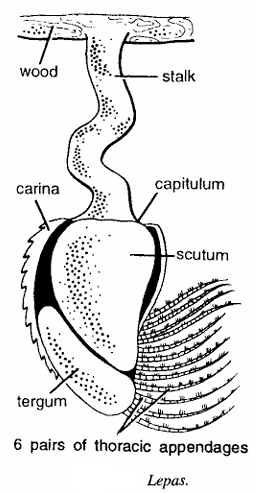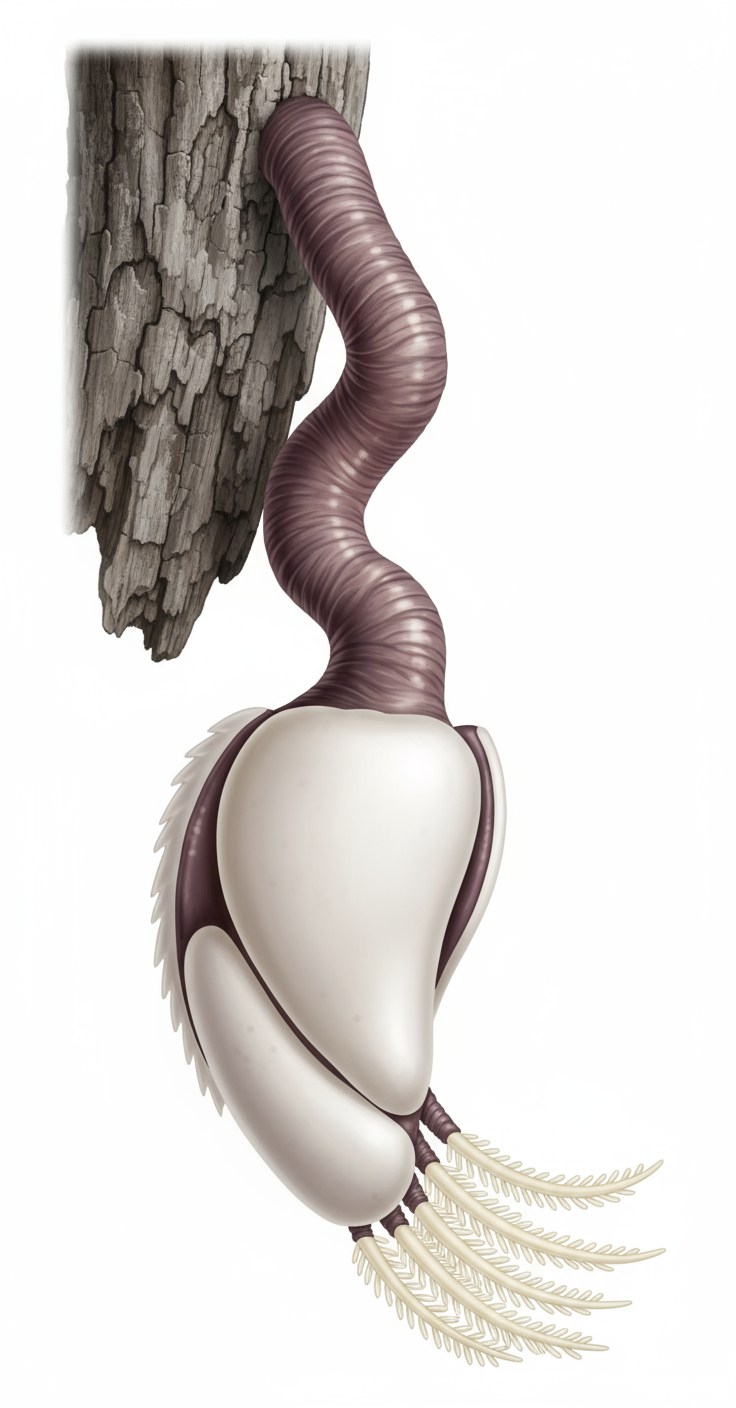Lepas: Morphology, Classification, Habitat, and Life History of the Goose Barnacle
Lepas is a cosmopolitan genus of stalked barnacles commonly called “goose barnacles,” belonging to the family Lepadidae. These pelagic cirripedes are known for their flexible, stalk-like peduncle and smooth, calcareous plates that surround the body, called the capitulum. Members of Lepas are easily recognized by their distinctive appearance and behavior, attaching themselves to floating objects such as driftwood, seaweed, ship hulls, and marine debris. Their unique adaptations to a drifting lifestyle and rapid global dispersal make them essential subjects of study in marine biology, particularly for tracking ocean currents and biofouling ecology.
Classification of Lepas
| Taxonomic Rank | Name | Characteristics |
|---|---|---|
| Kingdom | Animalia | Multicellular, eukaryotic organisms |
| Phylum | Arthropoda | Segmented invertebrates with jointed appendages |
| Subphylum | Crustacea | Aquatic arthropods with chitinous exoskeleton, branched limbs |
| Class | Maxillopoda | Small-bodied crustaceans, including barnacles and copepods |
| Subclass | Thecostraca | Crustaceans with carapaces; includes all barnacles |
| Infraclass | Cirripedia | True barnacles with feathery feeding appendages |
| Order | Pedunculata | Stalked barnacles with flexible peduncles |
| Family | Lepadidae | Goose barnacles with calcareous plates on capitulum |
| Genus | Lepas | Floating barnacles with flexible stalk and smooth capitular plates |

Habit and Habitat
Lepas species are obligate epipelagic drifters typically found attached to floating substrates, including driftwood, kelp holdfasts, seaweed, plastic debris, ships’ hulls, and even marine animals such as turtles. They inhabit warm temperate to tropical seas worldwide and are often abundant in oceanic gyres, coastal upwellings, and convergence zones.
Lepas attaches to floating debris using a cement produced from glands in the peduncle. Because they depend on floating materials, they are rarely found on stationary or submerged hard substrates. Their broad tolerance for environmental conditions, including temperature and salinity, makes them successful global colonizers.
Geographical Distribution
The genus Lepas is cosmopolitan and occurs in all major oceans and many marginal seas. Some of the most common species, such as Lepas anatifera and Lepas anserifera, are recorded in the Atlantic, Pacific, and Indian Oceans, as well as seas with regular floating debris. Species distribution is typically determined by the distribution of floating substrates and prevailing ocean currents.
General Characteristics
- Commonly called as goose barnacle or ship barnacle because barnacle geese were once thought to hatch from them.
- Animal is composed of bilaterally compressed vermiform and unsegmented body, the capitulum, and a peduncle.
- Peduncle or stalk is much narrower than the rest of the body and without scales.
- The peduncle is long and stout and acts a hold-fast organ.
- Body is flattened and covered by calcareous plates consisting of a pair of scuta at the stalk end, a pair of small terga at the opposite end, and a median dorsal carina lying along the hinge.
- Capitulum encloses the viscera and itself is encased in a bivalved carapace in which above plates are embedded.
- Six pairs of cirriform many-jointed, biramous thoracic appendages fringed with tuft of setae arise from the thorax.
- Mouth is ventral and anterior end is provided with mandibles and two pairs of maxillae. Antennae and paired eyes are absent.
- The outer plates of mantle are not fused to form a peripheral wall.
- Lepas is hermaphrodite but is having cross fertilization.
- Body Parts: Divided into a capitulum (the main body enclosed in five smooth, calcareous plates) and a peduncle (a tough, flexible stalk).
- Size: Capitulum can reach up to 5 cm; peduncle ranges from 4 to over 85 cm, according to substrate and species.
- Coloration: Capitulum predominantly white, often with pink, orange, or brown hues and scarlet edges; peduncle is purplish-brown and leathery.
- Cirri: Prominent, featherlike feeding appendages called cirri extend from the plates for filter feeding.
- Attachment: Strong cement gland in the peduncle ensures firm grip to floating or drifting objects.
- Symmetry: Capitulum shows bilateral symmetry; cirri project ventrally.

Special Features
- Feeding: Cirri extend and rhythmically beat to catch plankton and organic matter from the water.
- Egg Production: Ovoviviparous—broods eggs in the mantle cavity until hatching.
- Hermaphroditism: Simultaneous hermaphrodites; cross-fertilize with neighboring individuals.
- Larval Development: Eggs hatch into free-swimming nauplii that undergo several larval stages before settling and metamorphosing into adults.
- Dispersal: Excellent at long-distance dispersal due to drifting lifestyle; major contributors to biofouling communities.
Identification
Lepas species are identified by:
- Shape, arrangement, and sculpture of capitular plates.
- Length, thickness, and color of the peduncle.
- Habitat and substrate preference.
- Geographic location and associated marine debris.
- Genetic markers are increasingly used for accurate species distinctions.
Life Cycle and Reproduction
Lepas species are simultaneous hermaphrodites, capable of cross-fertilization via specialized copulatory organs. Eggs are fertilized internally and brooded in the mantle cavity. Developed larvae (nauplii) are released into the water column, dispersing as plankton for several stages before becoming cyprid larvae. The cyprid settles on suitable floating substrates and transforms into the adult barnacle.
The entire life cycle is adapted to rapid exploitation of ephemeral drifting habitats, allowing large aggregations to form quickly on available surfaces.
Ecological Role and Importance
- Filter Feeding: Contribute to marine food webs by consuming plankton, transferring energy up the food chain.
- Biofouling: Major fouling organisms on ships, buoys, and marine debris.
- Oceanic Indicator: Used to track oceanic currents and debris dispersal patterns.
- Food Source: Preyed upon by fish, birds, and invertebrates.
- Study Subject: Central to studies in marine dispersal, colonization, and climate change impacts.

References
- https://en.wikipedia.org/wiki/Lepas
- https://en.wikipedia.org/wiki/Lepas_anatifera
- https://animaldiversity.org/accounts/Lepas/classification/
- https://www.marlin.ac.uk/species/detail/2058
- https://animaldiversity.org/accounts/Lepas_anatifera/
- http://www.marinespecies.org/aphia.php?p=taxdetails&id=106048
- http://www.marinespecies.org/aphia.php?p=taxdetails&id=106087
- https://www.inaturalist.org/taxa/48778-Lepas-anserifera
- https://www.gbif.org/species/5166339
